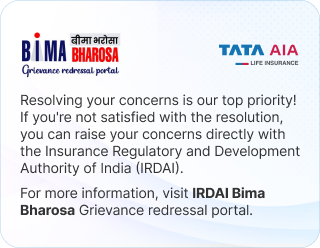Goods and Services Tax (GST) for Unit-Linked Insurance Plans (ULIPs) has been revised by the Indian Government. From 22 September 2025, ULIP premiums will not be subject to GST, making them more cost-effective. As a result of this change, ULIP policyholders can save significantly on their premiums. The new GST for ULIP plans aims to reduce costs for policyholders and expand coverage across the country. This article explains the new GST on ULIP plans.
What is GST?
Goods and Services Tax (GST) is a tax system introduced by the central government. To simplify India's complex tax structure, GST was introduced on July 1, 2017. Before GST, businesses and consumers had to deal with multiple taxes, including service tax, value added tax (VAT), central excise duty, and central sales tax. Due to these different taxes across states, there was confusion and inconsistency in the tax system. Thus, all these taxes have been included under GST, making tax management easier for businesses, consumers, and the government.
What is GST on ULIP?
From September 22, 2025, 0% GST will be levied on ULIP. Before this, 18% GST on ULIP premium was applied. Now, greater percentage of the premium amount will be invested in ULIP fund.
This revised GST on individual life insurance policies is intended to make insurance products cost-effective and accessible, enabling people to plan for the future. However, this exemption applies only to policies purchased after September 22, 2025. Policies purchased before this date will not qualify for the reduced GST rate.
GST for ULIP
Features |
Details |
GST on ULIP policy premium |
18% reduced to 0% |
Effective Date |
22 September 2025 |
GST on ULIP policy renewal |
18% reduced to 0% |
Expected Consumer Benefit |
This makes ULIPs cost-effective, potentially increasing investment growth and simplifying the premium structure for policyholders. |
Impact of GST on ULIP Premium
The removal of ULIP GST charges has made these plans more cost-effective for policyholders. There was previously an 18% GST rate on premiums, which increased the overall cost and reduced investments. Now that the GST for ULIP plan is 0%, policyholders have to only pay the premium amount, ensuring that a greater percentage of their money is invested in the ULIP fund. In the long term, this higher allocation can enhance the policy's returns and increase its maturity value. To better understand this impact, let's look at an example:
Particulars |
Earlier (Before 22 Sept 2025 – GST @18%) |
Now (From 22 Sept 2025 – GST @0%) |
Annual Premium |
₹1,00,000 |
₹1,00,000 |
GST |
₹18,000 |
₹0 |
Total Payable |
₹1,18,000 |
₹1,00,000 |
Benefits of GST reduction on ULIPs
The following are some of the main benefits:
- An increase in savings: With GST removed, ULIP premiums will be cheaper, allowing policyholders to save.
- Higher investment value: A larger percentage of premiums will be invested in the ULIP fund. Due to this, money is spent more efficiently on growth rather than taxes
- Improved long-term returns: Since GST for ULIP will be removed, policyholders will be able to get more units each year. Over time, the value of these extra units increases due to compounding, allowing the corpus to grow more rapidly. A policyholder can build wealth over time by accumulating these savings.
- Increased accessibility: With lower premium amounts, ULIP policies become financially accessible to a broader segment of the population.
- Encouragement for new policyholders: Individuals who have never bought ULIPs might consider buying them because of the revised GST on ULIP.
- Coverage at a lower cost: Since premiums are relatively low, individuals can choose policies with higher coverage or additional benefits without exceeding their budgets.
- Wider Insurance Coverage: Due to reduced GST on ULIP plans, the national objective of increasing life insurance penetration and providing basic financial protection for all citizens can be achieved.
- Available to rural and underserved areas: A reduction in policy costs allows insurers to offer budget-friendly plans in rural and remote areas. Thus, providing financial security to individuals previously underserved.
Who should consider buying ULIP policy after GST reduction?
The following groups can consider buying ULIP policy after GST reduction:
- New investors: With GST removed, ULIP premiums are lower, making it easier for people to purchase insurance for the first time. Now, they can invest and secure life cover simultaneously without having to pay high upfront costs.
- Young professionals: Reduced premium rates and the potential for long-term growth can benefit young professionals. As a result of starting early, more compounding time is available, helping to build a larger corpus over time.
- Middle-class families: Families with dependants can now afford ULIPs more easily. With the reduced cost, they can protect their loved ones while also saving for long-term goals such as their children's education, marriages, or retirements.
- Self-employed individuals: People without employer-sponsored insurance can purchase ULIPs to secure life insurance while also investing in market-linked funds.
- Low-income individuals: Rural residents or those with limited incomes can benefit from ULIPs. This helps them secure insurance coverage while also allowing small amounts to be invested for long-term growth.
Factors to consider before buying a ULIP plan with new GST rates
It is an appropriate time to invest in ULIPs due to the removal of GST on ULIPs. However, when choosing a policy, take into account the following factors:
- Understand your insurance and investment needs: Consider your family's financial needs, existing liabilities, and long-term goals such as retirement, child education, or wealth creation. This will help determine the appropriate premium amount and investment allocation.
- Compare plans and premiums: Insurance companies can charge different premiums despite the removal of GST. To make the right choice, it is important to compare policies based on their features, fund options, charges, and overall cost.
- Choose the right ULIP type: Make sure your investment and insurance combinations are appropriate for your goals. There are some ULIPs that focus on wealth creation with a higher equity allocation, while there are others that are more conservative or balanced.
- Check the claim settlement ratio: A high claim~ settlement ratio ensures that life cover claims are handled efficiently.
- Evaluate policy term and fund lock-in period: Consider your financial objectives and investment horizon when choosing the policy duration. There is a mandatory lock-in period of five years for ULIPs, so plan accordingly.
- Consider adding riders: With savings from GST reductions, riders such as critical illness, or accidental death riders can be added to enhance coverage.
- Choose a trusted insurer: Always purchase ULIPs from licensed agents, official websites, or authorised insurers to ensure safety, transparency, and regulatory compliance.
Conclusion
Due to the reduction in GST on ULIP premiums these plans have become more accessible and relatively less expensive. A policyholder will now only pay the premium, which allows them to invest a larger portion of their money in the ULIP fund. This can enhance their long-term returns. First-time investors, young professionals, middle-class families, and underserved segments may benefit from this change. Overall, the GST reduction on ULIP increases policyholders' access to insurance products and potential for financial growth potential.











 FOR EXISTING POLICY
FOR EXISTING POLICY 
 FOR NEW POLICY
FOR NEW POLICY 








